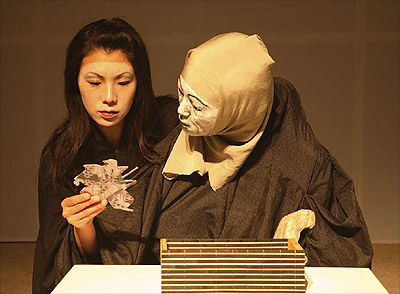
| HOME |
| NERVE |
| REVIEWS |
| ARCHIVE |
| EVENTS |
| LINKS |
| ABOUT US |
| CONTRIBUTORS |
| BACK ISSUES |
| CONTACT US |
 Urashima
Taro
Urashima
Taro
Written by Aya Nakamura and Paul Piris
Performed by Rouge28 Theatre
Unity Theatre
Wednesday 23rd Feb, 2011
Reviewed by Louise Costelloe-Ward and Hana Leaper
This production is based on the Japanese legend of Urashima Taro. In the original story, a poor fisherman saves a turtle that turns out to be Otohime, daughter of the king of the ocean. As a reward, he is invited to visit Otohime under the sea. Taro stays there for a few days, but soon wants to go back to his village to see his ageing mother. When he returns, his home is gone, his mother vanished and the people he knew are nowhere to be seen. He asks if anybody knows the house of Urashima Taro. They answer that they had heard someone of that name had vanished at sea hundreds of years ago. There are many variations on this ancient tale and Rouge28 Theatre have opted to focus upon the struggle between lust and duty, with less emphasis on the passage of time (the original denouement of the legend is portrayed as a dream).
There was a lot of unexpected, but welcome humour. Particular highlights included the post-coital cigarette wielding puppet and the evocation of frustrated parenting. The audience empathised with Otohime’s plight when her turtle-baby continues to wilfully drop its toy. Perhaps I should add that the cleverly screened sex scene between the actress playing Otohime and the puppet Taro was somewhat marred by my mind suddenly deciding to recall certain moments from Team America: World Police (2004). Vocal humour was also used as a ploy to highlight the artificiality of the paper theatre (Kamishibai) sections.
The play ended with a powerful and poignant death scene. Yes, that’s right a poignant puppet scene. This was partly down to the superb matching of sound to action, but also to the very clever design of the eponymous puppet. On Urashima Taro’s death, Otohime struggled to free his as yet unseen inner robes. This is an apt symbol of traditional Japanese lore regarding the struggle of souls to leave their bodies for the afterlife. The inner robes turned out to be fish netting, which added to the tangle, while reminding us of Urashima’s forgotten profession. When the soul was finally freed, the fishnet was illuminated in a fantastical manner to enhance the impression that Otohime was now dancing with a spectre. This final scene was both magical and sad, a fitting end to a unique experience.
Rouge28 Theatre has updated this story with a compelling combination of video projection, shadow play and puppetry. My only caveat is that I am unsure how easy it would have been to follow the action if I had not been versed in the original story beforehand. Fittingly, since some of the paper theatre used here is supposed to be the origin of Manga (read from back to front), the temporal disjunctions in this play mean it can be read neither forwards nor backwards.